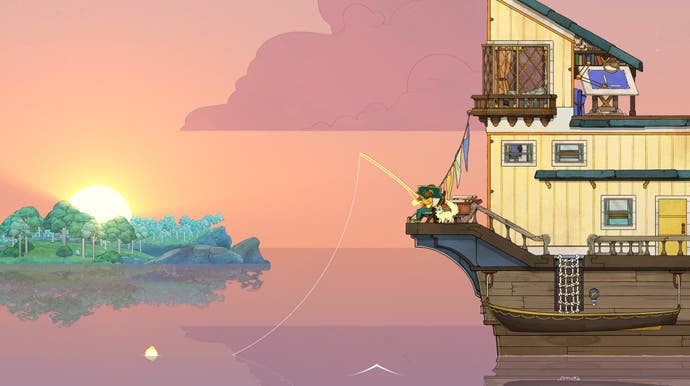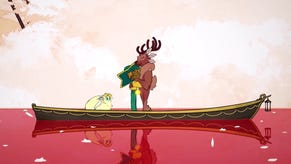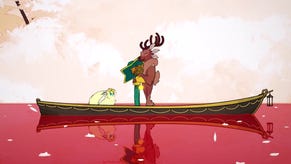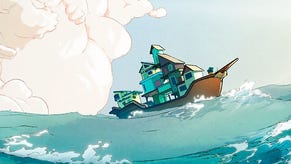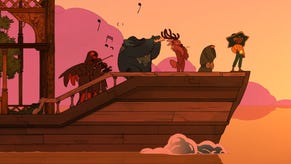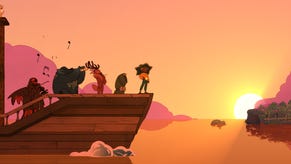Spiritfarer review - a beautiful, unique blend of genres
Fare play.
The ferryman has come to collect Stella for her last journey, on a plane between the land of the living and the afterlife. As she sits in Charon's boat, he gives her one final job - to help a few souls let go of the regrets that anchor them to life and allow them to pass on.
It sounds like a stately job. A cosy, tranquil journey. In reality however, Spiritfarer isn't a journey across calm seas so much as a sprint. You're given your own boat and set off to explore the spirit realm. In its towns and mountain villages you find spirits willing to join you, but before they can actually move on to the afterlife, you need to both build them a space on your boat to enjoy and coax out their story so they may eventually find closure.
Soon, an eclectic group of passengers settles in. Your first passenger, Dawn, for example, is a fawn with fur so plush it looks like she's wearing a stola. She also has a penchant for smoking. Your uncle Atul, a rotund frog, used to be a handyman and loves sharing food with others. Making them feel at home begins with gathering the resources needed to build a personalised cabin for each passenger. Distinct from the in- and outside, these cabins ooze flair and showcase their owners' personalities, but the best thing about them is how they sit on a boat. You stack them on top of each other like a game of management Tetris, and as your boat grows and you gain new buildings, you may have to move them around in order to find a good spot for each. Just watching the stack grow is an amazingly satisfying visual representation of progress. Stella navigates between these buildings like a character in a side-scrolling platformer, and she has similar abilities, too, which isn't surprising given Thunder Lotus' metroidvania roots.
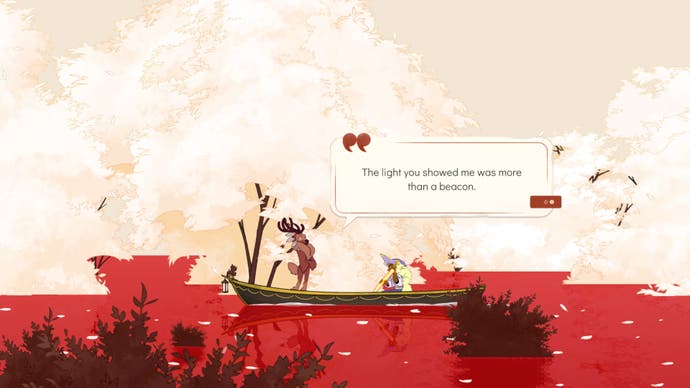
Jumping passages and a skill system for Stella are essential to traversal, and it still astounds me how well these systems fit with the rest. In order to fully explore each island, you need new skills, such as Stella floating on gusts of wind using her giant hat, which you acquire by using the obols your passengers give you at certain shrines. Revisiting places with new abilities in tow doesn't always yield exciting results - often it's little more than a few new cooking recipes - but the delight I felt at finally being able to fully unveil a place I visited earlier is similar to unlocking a new path in a 'real' metroidvania.
Your passengers are a demanding bunch, regularly crying for food or reminding you of their requests with frankly aggressive frequency. A house, even a swimming one, is only a home when it's filled with the things you love, and so they start asking you to craft improvements. On top of that the field needs to be tended, resources need to be gathered, the boat needs upgrading and food needs to come out of the oven on time.
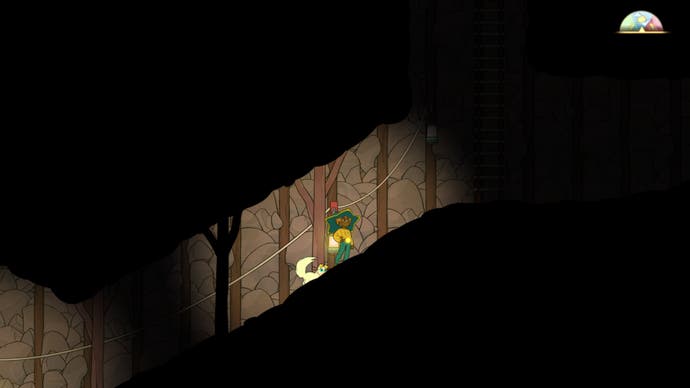
Anything you want to make soon requires items that take several steps to craft, too. The depth of the crafting system easily surpasses many similar systems I've come across, and it's the main reason for the game's formidable length of 30 hours for the critical path and almost 40 to find absolutely everything. The balancing of your tasks could be better: following someone's requests tends to end in a roadblock, where you can't craft the item they're asking of you because you don't own the facility yet, and you likely don't have the facility yet because you're missing another crafting resource to build it. To top it all off, just when you have all the items together you notice the boat is too small to accommodate the facility. I abandoned a lot of my plans because of this, and during the late game I would also backtrack to regions I had already combed over to collect a resource I otherwise hadn't needed in hours. Thankfully Spiritfarer does make this easier by allowing you to fast travel via a seal bus stop (don't ask, I don't know) or using the backs of three giant tortoise sisters to plant and resources on their backs and harvest them later (I guess giant tortoises really do carry the world on their back). I forgave these instances of nothing but collecting, though, because finally building something comes with the benefit of being able to discover a new place, meet a new friend, or advance in the story, all of which felt like rewards.
There's a lot to do, and that's why Spiritfarer is actually much easier to manage if you play it with a friend who takes control of Stella's faithful companion, Daffodil the cat. Having a second player with you can make the work go faster, but most resources also have a gathering method that benefits from a second pair of hands. If you smelt something in your forge, for example, you're using two bellows in turns to fan the flames until you reach the optimal temperature for the metal you're working. A single player has to run between the two bellows, whereas two players can do this more efficiently. The game offers simple, but fun minigames for some more exotic resources - all accompanied by a stunning soundtrack - and it would be a shame to spoil all of them for you. They don't overstay their welcome, and add further to the sense that Spiritfarer's world is a quirky place where anything is possible.
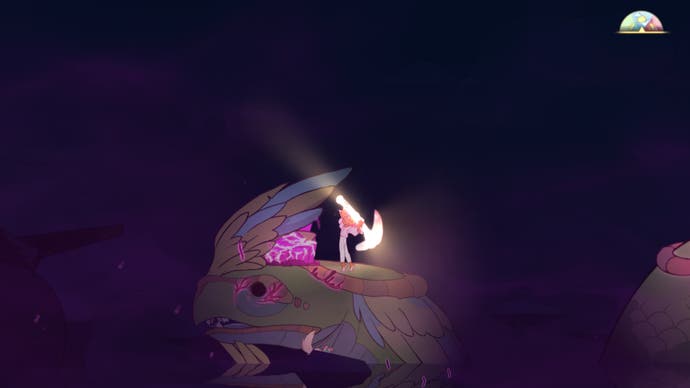
And the animation! Gosh, the animation. Spiritfarer's world is beautiful, but it's the amount of visual detail in each animation that really makes it something special. It's cartoonish and warm and feels so very real, from Stella stretching to pull a vegetable from the garden, bending all the way at the knees before pulling it up with a "hnnngh!", to passengers delightedly munching away at their food. That said, as neat as they are to look at, the animations are too long overall - I'm not a fighting game player counting frames, but with animations ranging from a minimum three to six seconds, you're dealing with a notable pause in which you're doing nothing but waiting for the animation to run through, which is especially jarring when some of them are so long because Stella just freezes in place for at least two seconds herself. Running and jumping are accompanied by an animation of her hitting the breaks, too, which makes it difficult to gauge when she actually comes to a halt and frequently made me slip off narrow platforms.
I really wanted the story to be the core of Spiritfarer, because it isn't just a wholesome experience (fast becoming something of a weird catch-all for combat free games), it's a positive look at death. The characters in Spiritfarer get to do what we all want - they can make peace with both their life and death in their own time. They get to decide when it's time to move on. As someone who has lost someone very abruptly, I'm jealous, because death seems much less scary when you reach some kind of understanding of it, or even when you simply get to decide when you're ready to let go of old regrets. To be fair, not everyone in Spiritfarer is that lucky, but they all get to live their best afterlife for a while.

As a player, it's easy to forget that this is the end goal of all of my sauerkraut making and furniture crafting, because compared to the vague snippets of their lives that the characters dole out, I spend a disproportionate amount of time doing other things. It's like working a shift at a nursery home where I take care of so many people that, completely overburdened, I only get to make superficial connections with everyone. I also don't know how I feel about the overall tone of the game, which is quite goofy, right until it isn't. I don't think Spiritfarer could've been solemn, not with its colourful cartoon style and anthropomorphic animals, but it's more of a soap opera than a musing on death. I guess that's life - a grand soap opera right until you have to face your own mortality - but Spiritfarer did give me quite severe whiplash at times (I guess that's life, too).
Your friends' last moments are truly something special, though. The moment you get to say goodbye makes everything worthwhile, because it feels like an arrival. It doesn't feel as if you've just successfully finished a portion of a game, it truly and honestly feels as if you've delivered a friend where they needed to go, and when they thank you, they don't do so in a stilted, gamey way that tells me I am the best, fantastic, the hero, but through positive reinforcement that feels truly genuine. I had to suspend my disbelief at bonds of such strength growing from what little I got to learn of each character, but with just a few lines, Spiritfarer regularly left me in tears.
It's a great show of what Thunder Lotus as a studio excels at, and a mix of contrasting genres that, despite occasional lengths, somehow just works. A pseudo-farming sim on a boat! What a concept.
